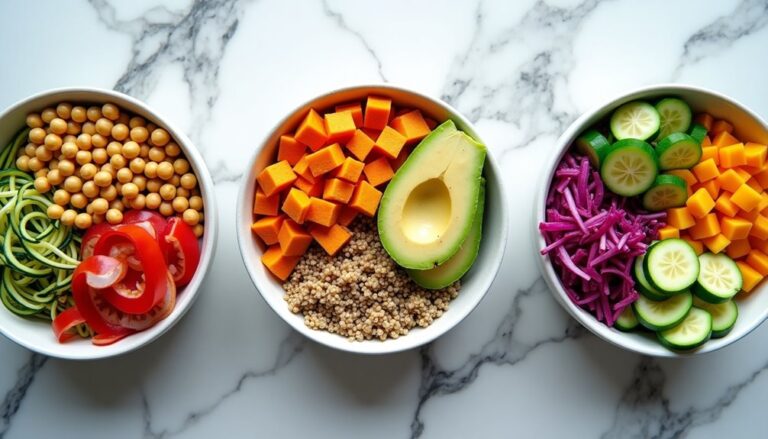18 Quick Plant Based Meals
You'll be amazed at how a well-stocked pantry of plant-based staples can transform into 18 different restaurant-worthy meals in under 30 minutes. From vibrant Mediterranean bowls bursting with chickpeas and fresh herbs to creamy mushroom pasta that rivals any traditional cream sauce, these recipes prove that quick doesn't mean boring. Whether you're a seasoned vegan or simply looking to add more plants to your diet, these versatile dishes offer something for every palate and skill level.
Mediterranean Chickpea Bowl
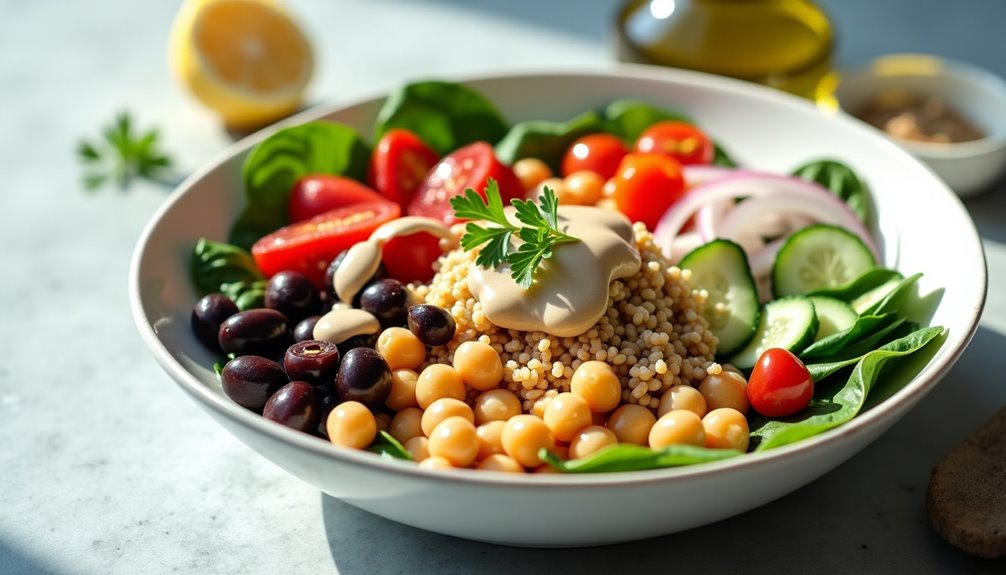
Mediterranean Chickpea Bowl combines the vibrant flavors of the Mediterranean region with protein-rich chickpeas and fresh vegetables. This colorful, nutrient-dense dish captures the essence of Mediterranean cuisine while offering a satisfying plant-based meal option.
This versatile bowl can be served warm or cold, making it perfect for meal prep or quick weeknight dinners. The combination of crisp vegetables, tender chickpeas, and aromatic herbs creates a balanced meal that's both healthy and flavorful, while the homemade tahini dressing adds a creamy finishing touch.
Ingredients:
- 2 cans chickpeas, drained and rinsed
- 2 cups cooked quinoa
- 2 cups cherry tomatoes, halved
- 1 cucumber, diced
- 1 red onion, thinly sliced
- 2 cups fresh spinach
- 1 cup kalamata olives
- 1/2 cup fresh parsley, chopped
- 1/4 cup tahini
- 2 lemons, juiced
- 3 cloves garlic, minced
- 2 tablespoons olive oil
- 1 teaspoon cumin
- Salt and pepper to taste
Start by preparing the tahini dressing: whisk together tahini, lemon juice, 1 clove of minced garlic, and 2-3 tablespoons of water until smooth. Season with salt and pepper to taste. For the chickpeas, heat olive oil in a pan over medium heat, add remaining garlic and cumin, then add chickpeas and cook until slightly crispy, about 5-7 minutes.
To assemble the bowls, start with a base of cooked quinoa, then arrange the crispy chickpeas, tomatoes, cucumber, red onion, spinach, and olives in sections around the bowl. Drizzle with the tahini dressing and garnish with fresh parsley.
For best results, store the dressing separately if meal prepping, and add it just before serving. The vegetables can be chopped in advance and stored in airtight containers for up to 3 days. To maintain the chickpeas' crispiness, reheat them separately in a pan before adding to the bowl.
15-Minute Tofu Stir-Fry

Minute Tofu Stir-Fry is a quick and protein-rich plant-based meal that combines crispy tofu with colorful vegetables in a savory sauce. This versatile dish can be prepared in under 30 minutes, making it perfect for busy weeknight dinners or when you need a nutritious meal without spending hours in the kitchen.
The key to a successful tofu stir-fry lies in properly pressing the tofu to remove excess moisture and achieving the right texture through quick, high-heat cooking. The vegetables remain crisp-tender, while the sauce brings everything together with a perfect balance of salty, sweet, and umami flavors.
- 1 block (14 oz) firm tofu
- 2 tablespoons vegetable oil
- 2 cups mixed vegetables (broccoli, carrots, bell peppers)
- 3 cloves garlic, minced
- 1 tablespoon ginger, minced
- 3 tablespoons soy sauce
- 1 tablespoon rice vinegar
- 1 teaspoon sesame oil
- 1 tablespoon cornstarch
- 1/4 cup water
- Salt and pepper to taste
- Optional: sesame seeds for garnish
Press the tofu between paper towels for 15 minutes, then cut into 1-inch cubes. Heat oil in a large wok or skillet over medium-high heat. Add tofu and cook until golden brown on all sides, about 5-7 minutes. Remove tofu and set aside.
In the same pan, stir-fry garlic and ginger for 30 seconds, then add vegetables and cook for 3-4 minutes. Mix cornstarch with water, soy sauce, rice vinegar, and sesame oil in a small bowl. Return tofu to the pan, pour the sauce mixture over everything, and cook until the sauce thickens, about 2 minutes.
For best results, ensure your pan is very hot before adding ingredients, and don't overcrowd the pan when cooking tofu. Cut vegetables into similar-sized pieces for even cooking, and have all ingredients prepped before starting to cook. The dish can be stored in an airtight container in the refrigerator for up to 3 days.
Creamy Mushroom Pasta
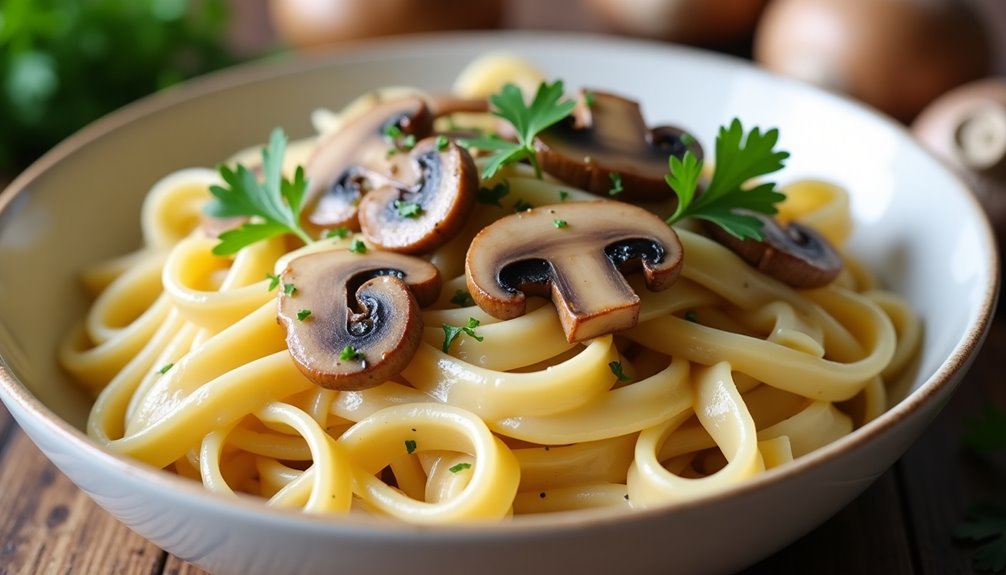
Creamy Mushroom Pasta combines the earthy richness of mushrooms with the comfort of pasta, creating a satisfying plant-based meal that doesn't compromise on taste or texture. The secret lies in selecting a variety of mushrooms, which provide different flavor profiles and textures, while the cream sauce is achieved through plant-based alternatives that maintain the dish's luxurious feel.
This recipe transforms simple ingredients into an elegant dinner option, perfect for both weeknight meals and special occasions. The umami-rich mushrooms and garlic create depth, while the herbs add brightness and complexity to the overall flavor profile.
Ingredients:
- 16 oz pasta (penne or fettuccine)
- 1 lb mixed mushrooms (button, cremini, shiitake)
- 4 cloves garlic, minced
- 1 medium onion, diced
- 2 cups unsweetened plant-based milk
- 2 tablespoons olive oil
- 2 tablespoons all-purpose flour
- 1 tablespoon nutritional yeast
- 1 teaspoon dried thyme
- 1 teaspoon dried rosemary
- Salt and black pepper to taste
- Fresh parsley for garnish
Start by heating olive oil in a large pan over medium heat. Sauté diced onions until translucent, then add minced garlic and cook for another minute. Add sliced mushrooms and cook until they release their moisture and begin to brown, about 8-10 minutes. Meanwhile, cook pasta according to package instructions in a separate pot.
Create the sauce by sprinkling flour over the mushroom mixture and stirring constantly for 1-2 minutes. Gradually add the plant-based milk while stirring to prevent lumps. Add nutritional yeast, thyme, rosemary, salt, and pepper. Simmer until the sauce thickens, about 5-7 minutes. Combine the cooked pasta with the mushroom sauce, stirring well to coat evenly.
For best results, avoid washing mushrooms directly under water as they absorb moisture easily. Instead, clean them with a damp cloth or paper towel. The sauce will continue to thicken as it cools, so if it becomes too thick, thin it out with a splash of reserved pasta water. Store leftovers in an airtight container in the refrigerator for up to 3 days.
Black Bean and Sweet Potato Tacos

Black bean and sweet potato tacos combine the earthy richness of black beans with the natural sweetness of roasted sweet potatoes, creating a satisfying plant-based meal that appeals to both vegetarians and meat-eaters alike. The contrasting textures and complementary flavors make this dish a crowd-pleasing option for casual dining or festive gatherings.
These tacos draw inspiration from traditional Mexican cuisine while incorporating modern plant-based elements. The combination delivers a protein-rich meal that's both nutritious and filling, with the sweet potatoes providing essential vitamins and fiber while the black beans offer substantial protein and minerals.
- 2 medium sweet potatoes, cubed
- 2 cans black beans, drained and rinsed
- 12 corn tortillas
- 1 red onion, diced
- 3 cloves garlic, minced
- 2 tablespoons olive oil
- 1 tablespoon cumin
- 1 teaspoon chili powder
- 1 teaspoon paprika
- Salt and pepper to taste
- Fresh cilantro
- 1 lime
- Optional toppings: avocado, salsa, vegan sour cream
Preheat the oven to 425°F (220°C). Toss cubed sweet potatoes with olive oil, cumin, chili powder, and paprika. Spread on a baking sheet and roast for 25-30 minutes until tender and slightly crispy, stirring halfway through.
Meanwhile, sauté diced onion and garlic in a pan until translucent, then add black beans and season with remaining spices. Heat through while mashing some of the beans for texture.
Warm the tortillas and assemble the tacos by layering the roasted sweet potatoes and seasoned black beans. Top with fresh cilantro, a squeeze of lime, and any additional toppings of choice.
For best results, avoid overcrowding the sweet potato cubes on the baking sheet as this can lead to steaming rather than roasting. The tortillas can be warmed directly over a gas flame for 10-15 seconds per side or wrapped in damp paper towels and microwaved. Store any leftover filling separately from the tortillas and reheat components individually for the best texture when serving later.
Quinoa Buddha Bowl

A quinoa buddha bowl is a nourishing and vibrant plant-based meal that combines the protein-rich ancient grain quinoa with colorful vegetables, legumes, and a flavorful dressing. This versatile dish can be customized according to seasonal produce and personal preferences, making it an excellent choice for meal prep or a quick weeknight dinner.
The key to a perfect buddha bowl lies in the balance of textures and flavors, from the fluffy quinoa base to the crispy roasted vegetables and creamy avocado. This recipe features a combination of roasted and raw vegetables, providing both warmth and freshness in every bite.
Ingredients:
- 1 cup quinoa
- 2 cups water
- 1 sweet potato, cubed
- 1 can chickpeas, drained and rinsed
- 2 cups kale, chopped
- 1 avocado, sliced
- 1 cup cherry tomatoes, halved
- 1 cucumber, diced
- 2 tablespoons olive oil
- 1 lemon, juiced
- 2 tablespoons tahini
- 1 clove garlic, minced
- Salt and pepper to taste
- 1 teaspoon cumin
- 1 teaspoon paprika
Start by rinsing the quinoa thoroughly and cooking it in water according to package instructions, typically simmering for 15-20 minutes until fluffy. While the quinoa cooks, preheat the oven to 400°F (200°C). Toss the sweet potato cubes and chickpeas with olive oil, cumin, paprika, salt, and pepper, then spread them on a baking sheet and roast for 25-30 minutes until golden and crispy.
For the dressing, whisk together tahini, lemon juice, minced garlic, and a splash of water to achieve a drizzling consistency. Massage the chopped kale with a small amount of olive oil and a pinch of salt to soften it. Once all components are ready, assemble the bowls by starting with a base of quinoa, then arranging the roasted vegetables, chickpeas, kale, cherry tomatoes, cucumber, and avocado in sections around the bowl. Drizzle with the tahini dressing just before serving.
For best results, roast the vegetables and chickpeas until they develop a slight char for maximum flavor. The components can be prepared in advance and stored separately in the refrigerator for up to three days, making this an excellent meal prep option. Just keep the avocado and dressing separate until ready to serve to maintain freshness and prevent oxidation.
Lentil and Spinach Curry
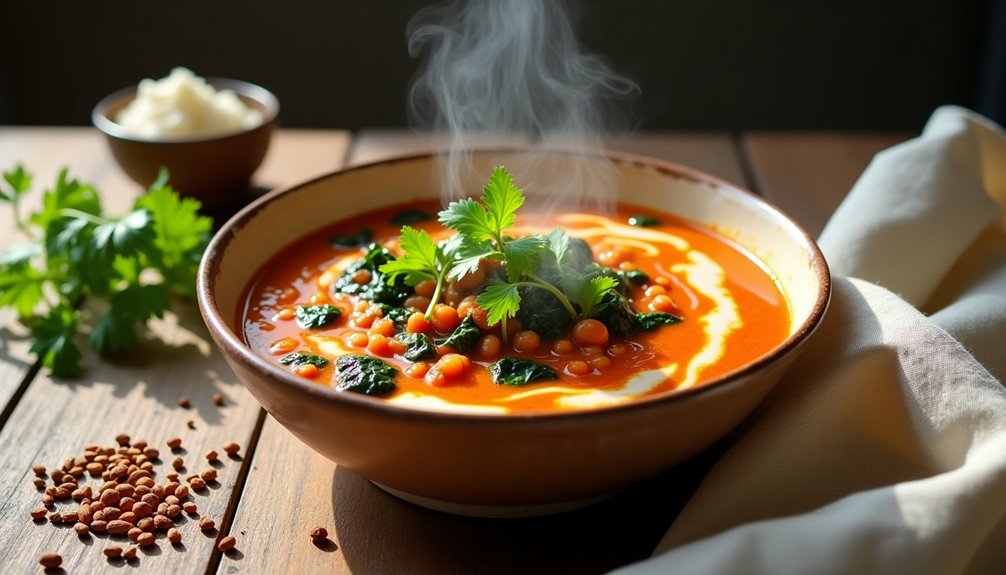
Lentil and spinach curry is a hearty, protein-rich dish that combines the earthiness of lentils with the fresh, vibrant flavors of spinach and aromatic Indian spices. This nutritious meal serves as an excellent introduction to plant-based cooking, offering a perfect balance of taste and health benefits.
This classic vegetarian curry takes approximately 45 minutes to prepare and can be served with rice, naan bread, or quinoa. The combination of red lentils and fresh spinach creates a creamy texture while providing essential nutrients like iron, fiber, and plant-based protein.
- 1 cup red lentils
- 4 cups fresh spinach, chopped
- 1 onion, finely diced
- 4 garlic cloves, minced
- 1 tablespoon ginger, grated
- 2 tomatoes, diced
- 2 tablespoons curry powder
- 1 teaspoon ground cumin
- 1 teaspoon ground coriander
- 1/2 teaspoon turmeric
- 3 cups vegetable broth
- 1 can coconut milk
- 2 tablespoons olive oil
- Salt and pepper to taste
- Fresh cilantro for garnish
Heat olive oil in a large pot over medium heat. Sauté onions until translucent, then add garlic and ginger, cooking for another minute. Add all spices and cook until fragrant. Add lentils, tomatoes, and vegetable broth, bringing to a boil before reducing heat to simmer for 20 minutes or until lentils are tender. Stir in coconut milk and spinach, cooking until spinach wilts and the curry reaches desired consistency.
For best results, toast the spices in the pan before adding wet ingredients to enhance their flavors. The consistency can be adjusted by adding more broth or coconut milk as needed. Fresh lemon juice can be added at the end for brightness, and the curry can be garnished with fresh cilantro before serving.
Thai Peanut Noodles

Thai Peanut Noodles are a versatile and flavorful plant-based dish that combines the rich, creamy texture of peanut sauce with tender rice noodles and crisp vegetables. This popular street food-inspired meal can be served hot or cold, making it perfect for any season or occasion.
The key to exceptional Thai Peanut Noodles lies in the balance of sweet, salty, tangy, and spicy flavors that characterize Thai cuisine. The sauce combines smooth peanut butter with coconut milk, soy sauce, lime juice, and other aromatics to create a complex taste profile that coats every strand of noodle.
- 8 oz rice noodles
- 1/2 cup natural peanut butter
- 1/4 cup coconut milk
- 3 tbsp soy sauce
- 2 tbsp rice vinegar
- 2 tbsp lime juice
- 2 tbsp maple syrup
- 2 cloves garlic, minced
- 1 tbsp ginger, grated
- 1 red bell pepper, julienned
- 2 carrots, julienned
- 1 cup edamame, shelled
- 3 green onions, sliced
- 1/4 cup cilantro, chopped
- Crushed peanuts for garnish
- Red pepper flakes to taste
Cook rice noodles according to package instructions until al dente. While the noodles cook, whisk together peanut butter, coconut milk, soy sauce, rice vinegar, lime juice, maple syrup, garlic, and ginger in a bowl until smooth. Drain the noodles and rinse with cold water to stop the cooking process.
In a large bowl, combine the noodles with the peanut sauce, tossing well to coat evenly. Add the bell pepper, carrots, edamame, and green onions, mixing gently to distribute the vegetables throughout. Top with cilantro and crushed peanuts, adding red pepper flakes if desired.
For best results, allow the dish to rest for 15-20 minutes before serving to let the flavors meld. The sauce will naturally thicken as it sits, and if it becomes too thick, thin it with a splash of warm water or additional coconut milk. Store leftovers in an airtight container in the refrigerator for up to three days, though the sauce may need to be thinned when reheating.
Roasted Vegetable Couscous
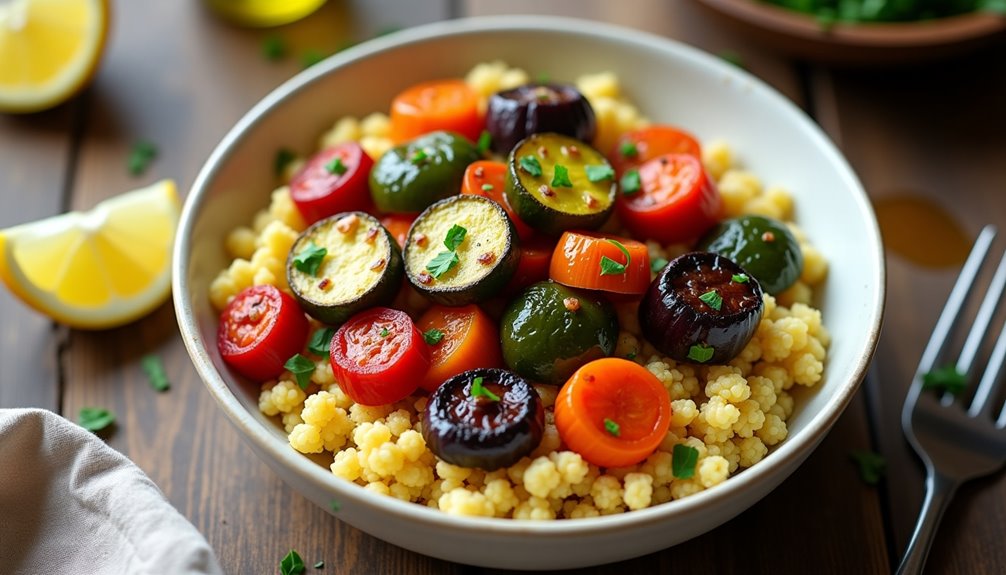
Roasted vegetables paired with fluffy couscous create a delightful Mediterranean-inspired dish that's both nutritious and satisfying. The natural sweetness of roasted vegetables combines perfectly with the light, delicate texture of properly prepared couscous, creating a balanced meal that can be served hot or at room temperature.
This versatile dish allows for seasonal adaptation, making it perfect year-round. While the recipe below suggests specific vegetables, feel free to experiment with whatever is fresh and available at your local market. The key lies in the roasting process, which caramelizes the vegetables and intensifies their flavors.
- 1½ cups couscous
- 2 cups vegetable broth
- 2 zucchini, chopped
- 2 red bell peppers, cut into chunks
- 1 red onion, cut into wedges
- 2 carrots, cut into chunks
- 1 small eggplant, cubed
- 3 tablespoons olive oil
- 2 teaspoons dried thyme
- 1 teaspoon ground cumin
- Salt and pepper to taste
- 2 tablespoons fresh lemon juice
- ¼ cup fresh parsley, chopped
Preheat the oven to 425°F (220°C). Toss the prepared vegetables with olive oil, thyme, cumin, salt, and pepper on a large baking sheet. Spread them in a single layer and roast for 25-30 minutes, stirring halfway through, until the vegetables are tender and lightly caramelized.
Meanwhile, bring the vegetable broth to a boil in a medium saucepan. Add the couscous, remove from heat, cover, and let stand for 5 minutes. Fluff with a fork and stir in lemon juice.
Combine the roasted vegetables with the couscous, gently tossing to mix. Adjust seasoning if needed and garnish with fresh parsley before serving.
For best results, cut vegetables into similarly sized pieces to ensure even cooking. Store any leftovers in an airtight container in the refrigerator for up to three days, though the couscous may become slightly dry. To reheat, sprinkle with a little water or broth and warm gently in the microwave or on the stovetop.
Tempeh and Broccoli Rice Bowl
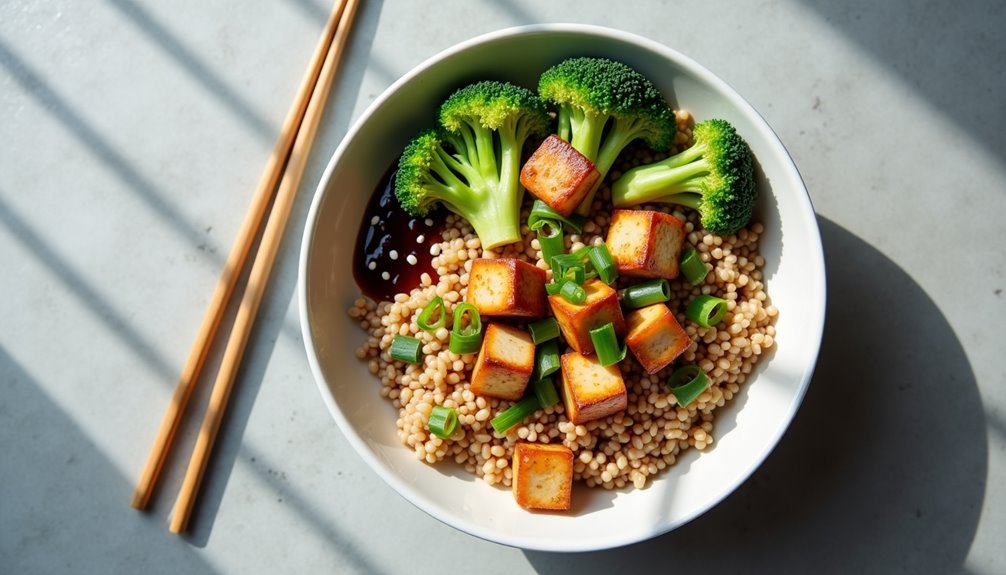
Tempeh, a traditional Indonesian protein made from fermented soybeans, offers a hearty and nutritious base for this satisfying rice bowl. Its firm texture and nutty flavor perfectly complement the fresh, crisp broccoli and aromatic seasonings used in this dish.
This Asian-inspired bowl combines simple ingredients to create a balanced meal that's both filling and healthy. The combination of protein-rich tempeh, fiber-packed broccoli, and complex carbohydrates from brown rice makes it an excellent choice for a post-workout meal or weeknight dinner.
Ingredients:
- 8 oz tempeh, cut into 1-inch cubes
- 2 cups broccoli florets
- 2 cups cooked brown rice
- 3 tablespoons soy sauce
- 2 tablespoons sesame oil
- 2 cloves garlic, minced
- 1 tablespoon ginger, grated
- 1 tablespoon rice vinegar
- 1 tablespoon maple syrup
- 2 green onions, sliced
- Sesame seeds for garnish
- Salt and pepper to taste
Begin by marinating the tempeh cubes in a mixture of soy sauce, sesame oil, minced garlic, and grated ginger for at least 15 minutes. While the tempeh marinates, steam the broccoli florets until bright green and tender-crisp, about 4-5 minutes. Heat a large skillet over medium-high heat and cook the marinated tempeh until golden brown on all sides, approximately 8-10 minutes.
Layer the cooked brown rice in bowls, top with the steamed broccoli and crispy tempeh. Drizzle with any remaining marinade and rice vinegar, then garnish with sliced green onions and sesame seeds.
For best results, prepare the brown rice in advance and let it cool slightly before assembling the bowls. The tempeh can be marinated overnight for deeper flavor, and the broccoli should maintain some crunch to provide textural contrast. Store any leftovers separately to maintain the optimal texture of each component.
Cauliflower Mac and Cheese
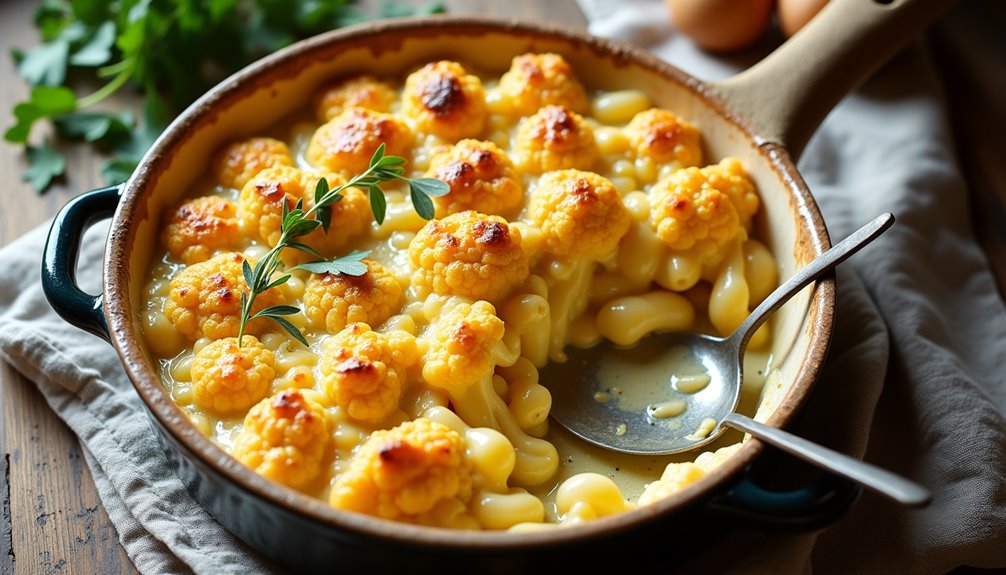
Cauliflower Mac and Cheese combines the comforting appeal of traditional mac and cheese with the nutritional benefits of vegetables. This plant-based version replaces conventional pasta with cauliflower florets, creating a low-carb alternative that maintains the creamy, satisfying nature of the original dish.
The dairy-free cheese sauce is crafted from a blend of cashews, nutritional yeast, and seasonings, delivering a rich, velvety texture that coats each piece of cauliflower perfectly. When baked, the dish develops a golden-brown crust while maintaining its creamy interior, making it an excellent choice for both casual dinners and special occasions.
Ingredients:
- 1 large head cauliflower, cut into florets
- 2 cups raw cashews, soaked overnight
- 1/2 cup nutritional yeast
- 1 cup plant-based milk (unsweetened)
- 2 cloves garlic
- 1 tsp onion powder
- 1 tsp mustard powder
- 1/2 tsp turmeric
- 1 tbsp lemon juice
- 1 tsp salt
- 1/4 tsp black pepper
- 1/2 cup breadcrumbs (optional)
Preheat the oven to 375°F (190°C). Steam or boil the cauliflower florets until tender but still firm, approximately 5-7 minutes. While the cauliflower cooks, prepare the cheese sauce by blending the soaked cashews, nutritional yeast, plant milk, garlic, and all seasonings until completely smooth and creamy.
Transfer the cooked cauliflower to a baking dish and pour the cheese sauce over it, ensuring even coverage. If desired, top with breadcrumbs for extra crunch. Bake for 25-30 minutes until the top is golden brown and the sauce is bubbling.
For best results, avoid overcooking the cauliflower during the initial cooking phase, as it will continue to soften during baking. The cheese sauce can be made ahead of time and stored in the refrigerator for up to three days. If the sauce thickens too much during storage, simply thin it with additional plant milk before using. For a nut-free version, consider substituting the cashews with silken tofu, adjusting the seasonings as needed for optimal flavor.
Three Bean Chili
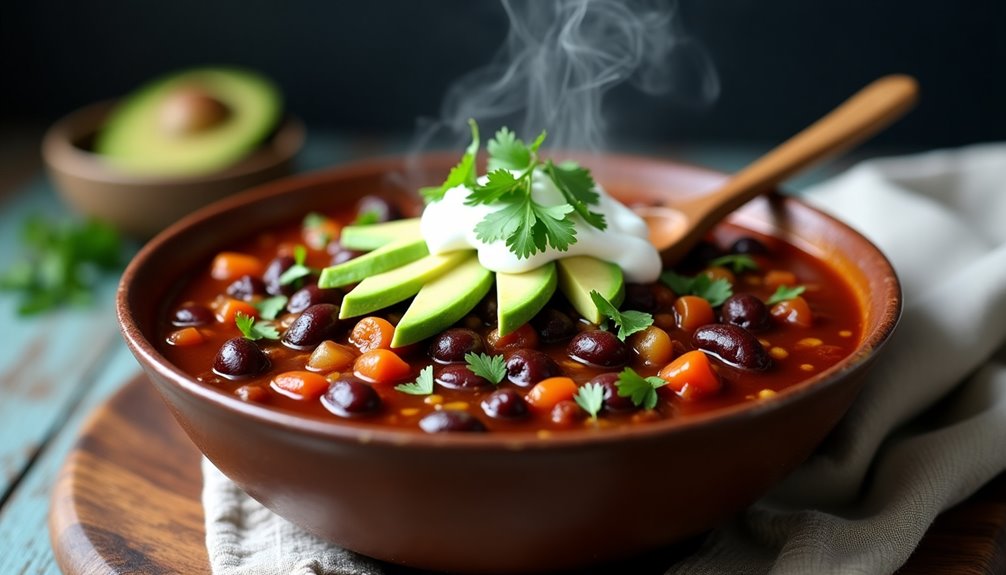
Three Bean Chili is a hearty, protein-rich vegetarian dish that brings warmth and comfort to any meal. The combination of different beans creates varying textures while providing essential nutrients, making it a perfect choice for those following a plant-based diet.
This recipe balances the earthiness of beans with aromatic spices and fresh vegetables, creating a complex flavor profile that develops further as it simmers. The natural starch from the beans helps thicken the sauce, resulting in a satisfying consistency that pairs well with rice, cornbread, or on its own.
- 1 can black beans, drained and rinsed
- 1 can kidney beans, drained and rinsed
- 1 can pinto beans, drained and rinsed
- 2 onions, diced
- 3 cloves garlic, minced
- 2 bell peppers, chopped
- 2 carrots, diced
- 2 celery stalks, diced
- 2 cans diced tomatoes
- 2 tablespoons olive oil
- 2 tablespoons chili powder
- 1 tablespoon ground cumin
- 1 teaspoon paprika
- 1 teaspoon oregano
- Salt and pepper to taste
- 4 cups vegetable broth
Heat olive oil in a large pot over medium heat. Sauté onions, garlic, bell peppers, carrots, and celery until softened, about 5-7 minutes. Add all spices and cook for another minute until fragrant. Pour in the vegetable broth, diced tomatoes, and all three types of beans. Bring to a boil, then reduce heat and simmer uncovered for 45-60 minutes, stirring occasionally until the chili reaches desired thickness.
For best results, prepare this chili a day ahead and refrigerate overnight to allow the flavors to fully develop. The chili can be frozen for up to three months, and you can adjust the spice level by adding or reducing the amount of chili powder. Consider serving with fresh cilantro, diced avocado, or vegan sour cream for added dimension.
Zucchini Noodle Alfredo

Zucchini noodles, also known as "zoodles," have revolutionized the way we think about pasta alternatives. This healthy, low-carb substitute maintains the satisfying texture of traditional pasta while significantly reducing calories and adding valuable nutrients to your meal. When paired with a creamy, dairy-free alfredo sauce, it creates a luxurious dining experience that's both comforting and nutritious.
The key to perfect zucchini noodle alfredo lies in properly preparing both the noodles and the sauce. The zucchini must be spiralized correctly and not overcooked to maintain its structure, while the cashew-based alfredo sauce needs to achieve the right consistency to coat the noodles effectively. This plant-based version of the classic Italian dish delivers rich, creamy flavors without heavy cream or cheese.
- 4 medium zucchini
- 1 cup raw cashews, soaked overnight
- 3 cloves garlic, minced
- 1 cup unsweetened almond milk
- 2 tablespoons nutritional yeast
- 1 tablespoon lemon juice
- 1 teaspoon sea salt
- 1/2 teaspoon black pepper
- 2 tablespoons olive oil
- 1/4 cup fresh parsley, chopped
Begin by spiralizing the zucchini using a spiralizer on the medium thickness setting. Place the zoodles in a colander and sprinkle with salt, allowing them to drain for 15 minutes to remove excess moisture.
Meanwhile, blend the soaked cashews, garlic, almond milk, nutritional yeast, lemon juice, salt, and pepper in a high-speed blender until completely smooth.
Heat olive oil in a large skillet over medium heat. Pat the zoodles dry with paper towels and add them to the skillet. Cook for 2-3 minutes, tossing gently. Pour the alfredo sauce into the pan and cook for an additional 2-3 minutes until the sauce is heated through and the zoodles are tender but still slightly crisp. Garnish with fresh parsley before serving.
For best results, avoid storing the prepared dish for later consumption, as zucchini noodles tend to release water over time and can become soggy. If you need to prepare components in advance, keep the spiralized zucchini and sauce separate until ready to serve. The sauce can be stored in an airtight container in the refrigerator for up to 5 days.
Veggie-Loaded Fried Rice
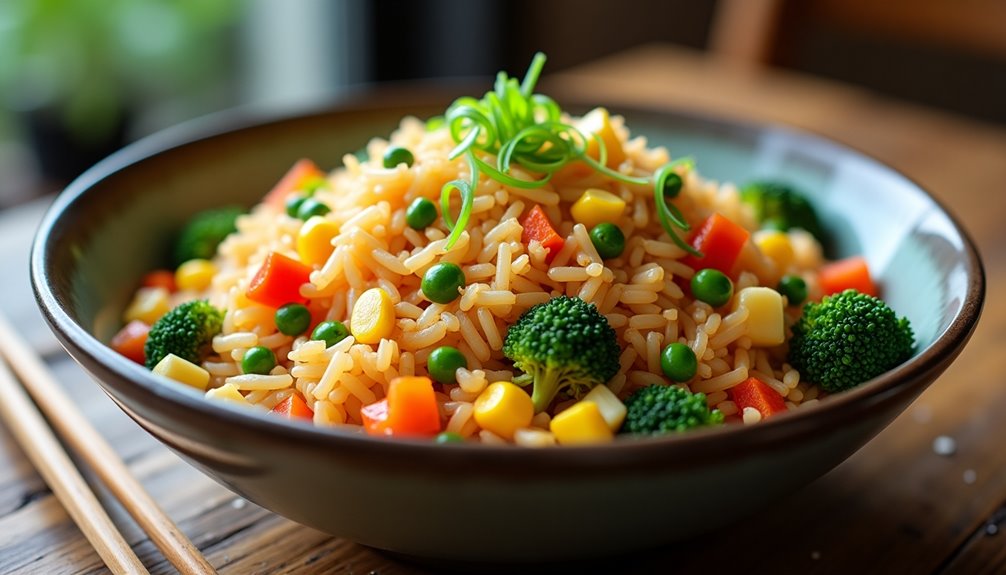
Veggie-loaded fried rice is a versatile and nutritious dish that transforms simple rice into a complete meal packed with colorful vegetables. This plant-based version eliminates the need for eggs or meat while maintaining all the satisfying flavors and textures of traditional fried rice.
The key to perfect fried rice lies in using day-old rice, as freshly cooked rice contains too much moisture and can become mushy. This recipe incorporates a rainbow of vegetables, creating a balanced meal that's rich in vitamins, minerals, and fiber while being completely plant-based.
- 3 cups cooked day-old rice
- 2 tablespoons vegetable oil
- 1 cup diced carrots
- 1 cup green peas
- 1 cup corn kernels
- 1 cup diced bell peppers
- 1 cup chopped broccoli
- 1/2 cup diced onions
- 3 cloves minced garlic
- 2 tablespoons soy sauce
- 1 tablespoon sesame oil
- 1/2 teaspoon black pepper
- Salt to taste
- Green onions for garnish
Begin by heating vegetable oil in a large wok or skillet over medium-high heat. Add onions and garlic, sautéing until fragrant and translucent. Add the diced carrots, broccoli, and bell peppers, cooking for 3-4 minutes until they begin to soften. Introduce the corn and peas, stirring frequently.
Add the day-old rice to the vegetable mixture, breaking up any clumps with a spatula. Pour in the soy sauce and sesame oil, stirring continuously to ensure even distribution. Continue cooking for 5-7 minutes, allowing the rice to crisp slightly and the flavors to meld together. Season with black pepper and salt to taste, then garnish with chopped green onions before serving.
For best results, prepare all vegetables before starting to cook and cut them into uniform sizes to ensure even cooking. If using frozen vegetables, thaw and drain them completely to prevent excess moisture. The rice can be cooked a day ahead and stored in the refrigerator, or you can use leftover rice from another meal. For additional flavor, consider adding ginger, chili sauce, or a dash of rice vinegar to customize the taste to your preferences.
Spicy Black Bean Burgers
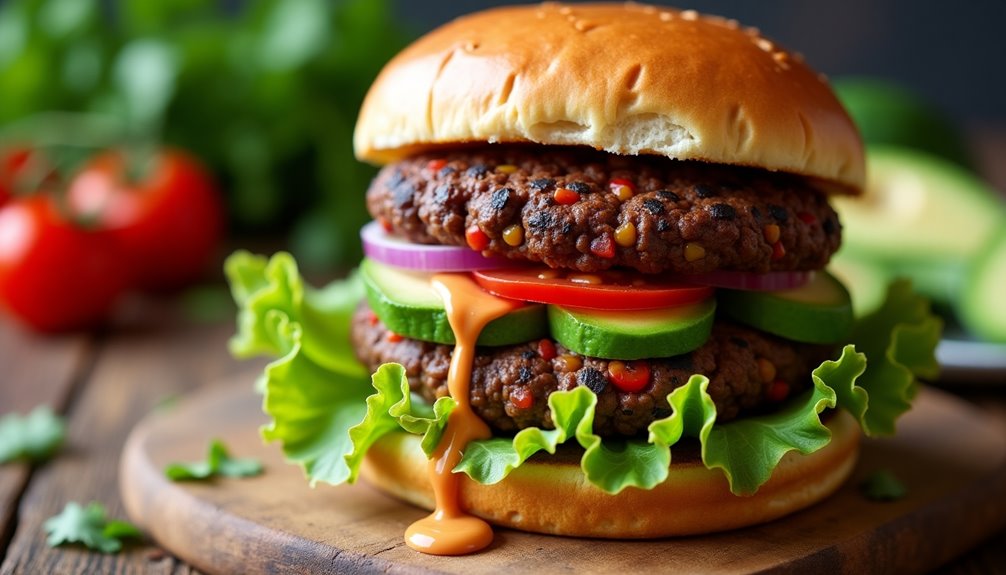
Spicy Black Bean Burgers are a delicious and nutritious alternative to traditional meat patties, offering a perfect blend of protein, fiber, and bold flavors. These plant-based burgers deliver a satisfying texture and can be customized to match your preferred level of spiciness.
When prepared correctly, black bean burgers hold together well and develop a crispy exterior while maintaining a tender interior. The combination of black beans, vegetables, and seasonings creates a depth of flavor that even meat enthusiasts can appreciate, making these burgers an excellent choice for family dinners or casual gatherings.
Ingredients:
- 2 (15 oz) cans black beans, drained and rinsed
- 1 red bell pepper, finely diced
- 1 medium onion, finely diced
- 3 cloves garlic, minced
- 2 cups breadcrumbs
- 2 large eggs (or flax eggs for vegan version)
- 2 tablespoons cumin
- 2 teaspoons chili powder
- 1 teaspoon cayenne pepper
- 1 teaspoon paprika
- Salt and black pepper to taste
- 3 tablespoons olive oil
Begin by mashing the black beans in a large bowl, leaving some beans partially whole for texture. Sauté the diced onion, bell pepper, and garlic in 1 tablespoon of olive oil until softened, then add to the mashed beans. Mix in the breadcrumbs, eggs, and all seasonings until well combined. Form the mixture into 6-8 patties, approximately 1 inch thick.
Heat the remaining olive oil in a large skillet over medium heat. Cook the patties for 4-5 minutes on each side until they develop a golden-brown crust. Alternatively, bake the patties in a preheated 375°F oven for 20-25 minutes, flipping halfway through.
For best results, chill the formed patties in the refrigerator for at least 30 minutes before cooking to help them hold together better. The patties can be made ahead and frozen for up to three months – simply separate them with parchment paper before freezing. Serve these burgers on toasted buns with your favorite toppings such as avocado, lettuce, tomato, or chipotle mayo.
Rainbow Grain Bowl

Rainbow Grain Bowl is a vibrant, nutrient-packed dish that combines wholesome grains with an array of colorful vegetables, creating a perfectly balanced meal. The combination of textures, from the chewy grains to crisp vegetables and creamy dressing, makes every bite interesting and satisfying.
This versatile bowl can be customized based on seasonal produce and personal preferences, while maintaining its core elements of grains, proteins, and vegetables. The dish works equally well served warm or cold, making it an excellent option for meal prep or quick weekday lunches.
Ingredients:
- 1 cup quinoa or brown rice
- 2 cups water
- 1 cup purple cabbage, shredded
- 1 medium carrot, julienned
- 1 yellow bell pepper, sliced
- 1 cup cherry tomatoes, halved
- 1 cup edamame, shelled
- 1 avocado, sliced
- 1 cup chickpeas, cooked
- 2 tablespoons olive oil
- 1 tablespoon lemon juice
- 1 tablespoon soy sauce
- 1 teaspoon sesame seeds
- Salt and pepper to taste
Rinse the grain of choice thoroughly and cook it according to package instructions using water and a pinch of salt. While the grain cooks, prepare all vegetables by washing, cutting, and arranging them in separate piles. Once the grain is cooked, let it cool slightly if serving at room temperature, or use immediately if serving warm.
To assemble, place the cooked grain as the base in each bowl. Arrange the prepared vegetables, edamame, and chickpeas in sections around the bowl, creating a rainbow effect. Whisk together olive oil, lemon juice, and soy sauce in a small bowl, then drizzle over the assembled bowls. Sprinkle with sesame seeds, salt, and pepper.
For best results, consider prepping ingredients in advance and storing them separately in airtight containers. The dressing can be made ahead and stored for up to a week in the refrigerator. To maintain the freshness of the avocado, add it just before serving, and toss it in a bit of lemon juice to prevent browning. The grain bowl can be customized with different dressings, such as tahini or miso-based options, for variety.
Chickpea Coconut Curry
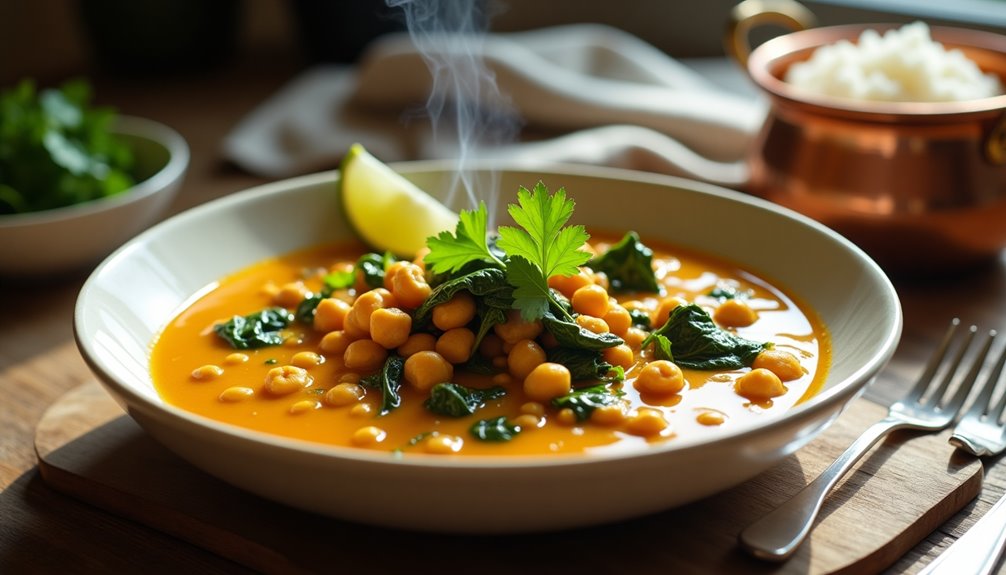
Chickpea Coconut Curry is a rich, flavorful dish that combines the heartiness of legumes with the creamy sweetness of coconut milk. This plant-based curry draws inspiration from Indian cuisine while incorporating elements that make it accessible for home cooks of any skill level.
The combination of aromatic spices, tender chickpeas, and smooth coconut milk creates a satisfying meal that can be served over rice or with flatbread. This curry comes together in under an hour and makes excellent leftovers as the flavors continue to develop over time.
Ingredients:
- 2 cans chickpeas (15 oz each), drained and rinsed
- 2 cans coconut milk (14 oz each)
- 1 large onion, diced
- 4 cloves garlic, minced
- 1 tbsp fresh ginger, grated
- 2 tbsp curry powder
- 1 tsp ground cumin
- 1 tsp ground turmeric
- 1 tsp ground coriander
- 2 tbsp tomato paste
- 2 cups spinach
- Salt and pepper to taste
- 2 tbsp vegetable oil
- Fresh cilantro for garnish
- 1 lime, juiced
Heat oil in a large pot over medium heat and sauté onions until translucent. Add garlic and ginger, cooking until fragrant. Stir in all the spices and tomato paste, then add chickpeas and coconut milk. Bring to a simmer and cook for 20-25 minutes, stirring occasionally. Add spinach in the last 5 minutes of cooking and finish with lime juice.
Let the curry rest for 5-10 minutes before serving to allow the flavors to settle and the sauce to thicken slightly. Garnish with fresh cilantro and serve hot over your choice of rice or with naan bread.
The consistency of the curry can be adjusted by simmering longer for a thicker sauce or adding water for a thinner consistency. Using full-fat coconut milk will result in a richer, creamier curry, while light coconut milk can be used for a lower-calorie version. For meal prep, this curry can be stored in an airtight container in the refrigerator for up to 5 days.
Asian-Style Lettuce Wraps
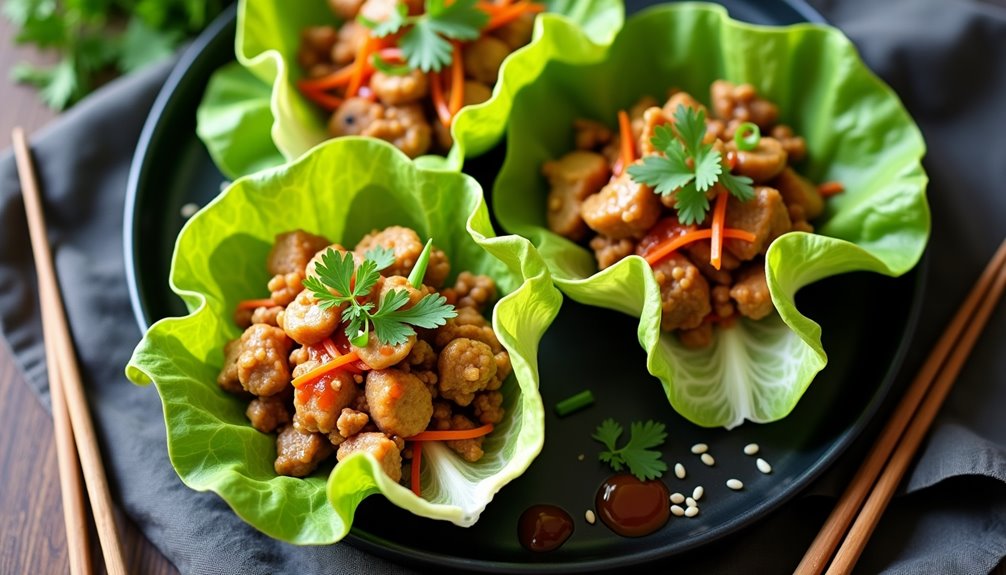
Asian-Style Lettuce Wraps blend the fresh crispiness of lettuce leaves with savory, seasoned fillings to create a light yet satisfying meal. This dish gained popularity in Western restaurants but originates from various Asian cuisines, where lettuce wraps have been enjoyed for generations.
The key to perfect lettuce wraps lies in the balance between textures and flavors – combining crispy vegetables, tender protein, and umami-rich sauce with the cool crunch of fresh lettuce. This recipe uses plant-based protein crumbles as the main filling, making it suitable for vegetarian and vegan diets while maintaining the traditional taste profile.
- 1 head butter lettuce or iceberg lettuce
- 16 oz plant-based ground protein
- 1 cup diced mushrooms
- 1/2 cup diced water chestnuts
- 1/2 cup shredded carrots
- 4 cloves minced garlic
- 1 tablespoon minced ginger
- 3 tablespoons soy sauce
- 2 tablespoons hoisin sauce
- 1 tablespoon rice vinegar
- 1 teaspoon sesame oil
- 2 green onions, sliced
- 1/4 cup chopped cilantro
- 2 tablespoons neutral cooking oil
Heat cooking oil in a large skillet over medium-high heat. Add garlic and ginger, sautéing until fragrant. Add the plant-based protein and cook until browned, breaking it up into small pieces. Incorporate mushrooms, water chestnuts, and carrots, cooking until vegetables are tender.
Mix in soy sauce, hoisin sauce, rice vinegar, and sesame oil. Simmer for 5 minutes, allowing the flavors to meld. Remove from heat and stir in green onions and cilantro. Gently separate and wash lettuce leaves, then pat dry. Spoon the filling mixture into individual lettuce leaves when ready to serve.
For best results, serve the components separately and let diners assemble their own wraps. This prevents the lettuce from becoming soggy and allows everyone to control their portions. Store leftover filling in an airtight container for up to three days, reheating only the amount needed for each serving. The lettuce leaves should be stored separately and prepared fresh for each meal.
Portobello Mushroom Fajitas
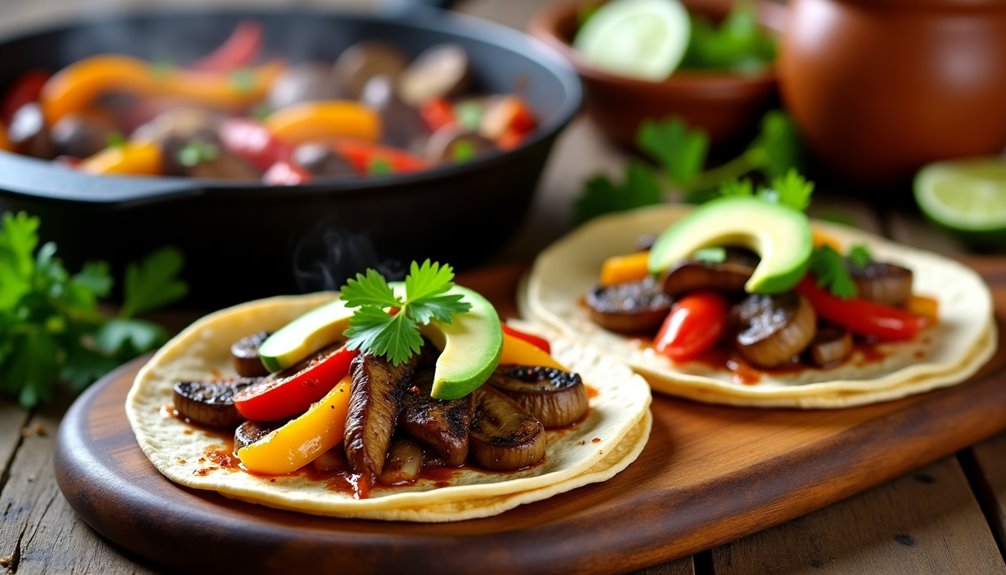
Portobello mushroom fajitas offer a meaty, satisfying alternative to traditional beef or chicken fajitas while remaining completely plant-based. The large, robust mushrooms provide a hearty texture and their natural umami flavor perfectly complements the classic fajita seasonings and vegetables.
These fajitas can be prepared in under 30 minutes and make an excellent weeknight dinner option. The combination of seared mushrooms, colorful bell peppers, and caramelized onions creates a visually appealing and flavorful meal that will satisfy both vegetarians and meat-eaters alike.
Ingredients:
- 4 large portobello mushrooms, sliced
- 2 bell peppers (mixed colors), sliced
- 1 large onion, sliced
- 3 cloves garlic, minced
- 2 tablespoons olive oil
- 1 tablespoon lime juice
- 1 teaspoon ground cumin
- 1 teaspoon chili powder
- 1/2 teaspoon smoked paprika
- Salt and pepper to taste
- 8-10 flour tortillas
- Optional toppings: avocado, lime wedges, cilantro, salsa
Heat a large skillet or cast-iron pan over medium-high heat. Add olive oil and allow it to heat up before adding the sliced mushrooms. Cook them without stirring for 3-4 minutes to achieve a good sear. Add the onions and bell peppers, cooking for another 5-7 minutes until the vegetables are tender but still slightly crisp. Add the garlic and seasonings, stirring to combine, and cook for an additional 1-2 minutes. Finish with a squeeze of lime juice.
For best results, clean the mushrooms with a damp paper towel instead of washing them under running water, as excess moisture will prevent proper searing. Make sure to slice all vegetables in similar thickness for even cooking, and avoid overcrowding the pan to ensure proper caramelization. Warm the tortillas separately in a dry skillet or wrapped in foil in the oven for the best serving temperature.




